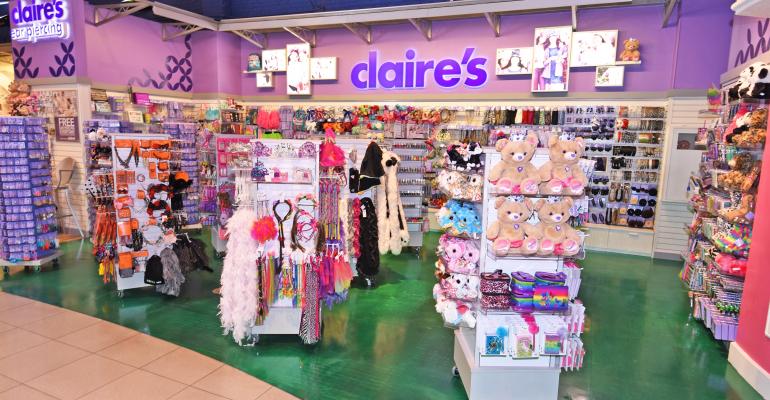(Bloomberg)—Heavily indebted retailers J. Crew Group Inc. and Claire’s Stores Inc. are delving into their loan agreements to find creative ways to raise or reconfigure their debt. And creditors, who often have the most to lose, may not be able to stop them.
Take the case of preppy clothing maker J. Crew. The New York-based company is said to be seeking to take advantage of a clause in its loan agreement allowing it to shift its brand name, the crown jewel of its intellectual property, to an unrestricted entity in the Cayman Islands. By doing this, it may now be possible for J. Crew to borrow against the assets and use the proceeds to buy back a portion of its roughly $2 billion in debt at a discount.
“There may be other situations, but we haven’t seen retail companies using IP assets and investment baskets like this before,” said Steven Ruggiero, head of research at R.W. Pressprich & Co. “They are taking advantage of valuable assets that haven’t been optimally utilized to find new creative ways to create liquidity to extend their existence.”
Transferring assets and investments to unrestricted entities can hurt creditors because new secured debt issued against them can get priority over their claims, potentially lowering the value of their holdings and preventing them from being paid first in case of bankruptcy. In industry parlance, they would have been ‘primed’.
So J. Crew’s term lenders are said to be talking to lawyers and preparing for a potential fight. Specifically, they’re digging into the lending documents to see whether they can push back on the transfer.
A spokeswoman for J. Crew declined to comment on the company’s borrowing.
Gray Area
“It’s a gray area,” Ruggiero said. “Creditors will get legal help to start analyzing what can be contended. But the reality is litigation may be hard unless it is determined that there was a breach of the lenders’ contracts. In most cases, they are legal.”
These asset-shielding tactics aren’t exactly new to indebted retailers -- Sears Holdings Corp. used a similar maneuver nine years ago in the spinoff of its popular Craftsman, Kenmore and DieHard lines.
And companies in other industries use them as well. Cellular carrier Sprint Corp. created an unrestricted entity and moved its wireless spectrum assets into it. In October, it sold $3.5 billion of secured notes backed by those assets. Sprint has an option to issue another $3.5 billion of securities if it chooses.
Just last week, lenders to Core Media Group Inc., the American Idol producer that filed for bankruptcy in April, filed a suit in a California court arguing that owner Apollo Global Management LLC had inappropriately shifted assets out of the business without the lenders being repaid.
“The lawsuit is without merit and we intend to defend ourselves vigorously,” Apollo spokesman Charles Zehren said in a statement.
And consider iHeartMedia Inc. The company transferred shares from its billboard unit to an unrestricted subsidiary triggering a legal fight with noteholders. The company won that lawsuit. Disputes involving IHeartMedia and bondholders may set significant precedents for other indebted borrowers, Anthony Canale, head of high-yield research at Covenant Review, said in a Nov. 29 webinar with BI.
Monitoring Litigation
A number of high-yield issuers “are actively monitoring this litigation with an eye toward using this concept and this strategy of unrestricted subsidiaries to opportunistically address their capital structures,” Canale said.
Claire’s Stores, the tween jewelry chain also owned by Apollo, used a similar tactic earlier this year when it set up an unrestricted subsidiary and got a $130 million loan agreement to support a distressed debt exchange.
“So the takeaway from Claire’s is that, even though incremental first lien debt capacity was very limited in this credit, the company was able to still significantly prime existing first-lien bondholders in large part by moving this value to an unrestricted subsidiary and incurring the debt there,” said BI’s Richard Bourke in the webinar.
A spokeswoman for iHeart declined to comment. Representatives for Claire’s Stores didn’t immediately respond to requests seeking comment.
On Dec. 12, Fitch Ratings listed Claire’s as one of the retailers that’s “challenged to maintain share, liquidity and positive comps” after earlier naming it as one of seven chains at high risk of defaulting on its debt. And despite all the debt creativity, these moves still don’t address the company’s much wider problem: declining traffic in malls.
“It doesn’t fix that,” Bloomberg Intelligence analyst Noel Hebert said in the same webinar. “And it doesn’t really fix the need to kind of repair the balance sheet.”
To contact the reporter on this story: Jodi Xu Klein in New York at [email protected] To contact the editors responsible for this story: Christopher DeReza at [email protected] Eric J. Weiner, Faris Khan
COPYRIGHT
© 2016 Bloomberg L.P

